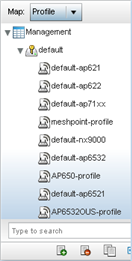Management Access policies display in the lower left-hand side of the controller, service platform or access point UI. Existing policies can be updated as management permissions change, or new policies can be added as needed.
To view existing Management Access policies:
Select Configuration > Management > Management Policy to display the main Management Policy screen and Management Browser.
Select a policy from the Management Browser or refer to the Management screen (displayed by default) to review existing Management Access policy configurations at a higher level.

The Management Policy screen displays existing management policies and their unique protocol support configurations.

Refer to the following Management access policy configurations to determine whether these existing policies can be used as is, require modification or a new policy requires creation:
A green check mark indicates controller, service platform or access point access is allowed using the listed protocol. A red X indicates device access is denied using the listed protocol.
|
Management Policy |
Displays the name of the Management Access policy assigned when initially created. The name cannot be updated when modifying a policy. |
|
Telnet |
Telnet provides a command line interface to a remote host over TCP. Telnet provides no encryption, but it does provide a measure of authentication. |
|
SSHv2 |
SSH (Secure Shell) version 2, like Telnet, provides a command line interface to a remote host. However, all SSH transmissions are encrypted, increasing their security. |
|
HTTP |
HTTP (Hypertext Transfer Protocol) provides access to the device's UI using a Web browser. This protocol is not very secure. |
|
HTTPS |
HTTPS (Hypertext Transfer Protocol Secure) provides fairly secure access to the device's GUI using a Web browser. Unlike HTTP, HTTPS uses encryption for transmission, and is therefore more secure. |
|
SNMPv1 |
SNMP (Simple Network Management Protocol) exposes a device's management data so it can be managed remotely. Device data is exposed as variables that can be accessed and modified. SNMP is generally used to monitor a system's performance and other parameters. SNMP v1 is easy to set up, and only requires a plain text. It does not support 64 bit counters, only 32 bit counters, and that provides little security. |
|
SNMPv2 |
SNMP v2 is identical to version 1, but it adds support for 64 bit counters. Most devices support SNMP v2c automatically. However, there are some devices that require you to explicitly enable v2, and that poses no risk. |
|
SNMPv3 |
SNMP v3 adds security to the 64 bit counters provided with SNMP v2. SNMP v3 adds both encryption and authentication, which can be used together or separately. Its setup is more complex than just defining a community string. But if you require security, SNMP v3 is recommended. |
|
FTP |
FTP (File Transfer Protocol) is a standard protocol for files transfers over a TCP/IP network. |
If it's determined a Management Access policy requires creation or modification, refer to Adding or Editing a Management Access Policy. If necessary, select an existing Management Access policy and select Delete to permanently remove it from the list of those available.